Atmospheric Lensing.
A Weapon of Selective Destruction
by Steven J. Smith
http://www.whale.to/b/atmospheric_lensing.html
by Steven J. Smith
http://www.whale.to/b/atmospheric_lensing.html
1.1.1
Introduction:
When it comes to war, America portrays it self as a nation
of compassion. All to often, it is also a nation paralyzed
by political division. Therefore from the American
political and military perspective, the best weapon system
would not go "bang", or leave smoking holes in the ground to
be photographed by news reporters. It would be a weapon of
stealth, bringing silent death to the opponent. Preferably
without the adversary even knowing they are under attack, or
what has caused their demise. This ideal weapon system
would have the twin characteristics of being both very
selective in it's destructive powers, and able to reach
inside buildings or other structures without the need for
physical intrusion that might be detected, or worse (from a
political viewpoint), publicized. If such a weapon were to
exist, it would be prized above all others by the American
government, since it would serve the twin goals of
"compassionate war", and "avoidance by stealth" of political
paralysis and/or retribution. If you think such a weapon
system is science fiction, prepare for a shock, because it's
already deployed and fully operational.
1.1.2
Refraction:
Refraction is the property of transparent materials to bend
light. All transparent materials exhibit this property.
Refractive index (sometimes called index of refraction) is
a numerical measurement of this property. By definition,
the refractive index of free space is set to 1. All
transparent materials bend light more than free space, and
therefore have a refractive index greater than 1. In other
words, given two materials of the same thickness, the
material with a higher refractive index will bend light more
than the material with a lower refractive index.
1.1.3
Secondary Effects:
In most materials, changes in environmental conditions
(temperature, pressure, etc.) cause corresponding shifts in
refractive index. This is especially true of gaseous
materials where pressure and temperature have a large
influence over refractive index. The presence of
electromagnetic fields can also influence refractive index,
and again, gaseous materials are far more susceptible.
Further, the refractive index of any given material will
change for different wavelengths of light. A prism is a
good example of this last phenomena. White light enters the
prism, and since different wavelengths (colors) are bent by
differing amounts, a spectrum of colored light emerges from
the far side.
1.1.4
The Optical Lens and Mirror:
It is the phenomena of refraction, along with geometric
shape that allows a lens to focus light. Given a pair lens,
made from identical materials, the lens with greater
curvature will have a shorter focal length. Given a pair of
lens made from differing materials, and with identical
curvature, the lens with a higher refractive index, will
have a shorter focal length. In other words, both curvature
AND refractive index determine lens focal length. Some
types of mirrors and optical filters also depend on
refraction for their functionality. Reflection from a
non-metallic surface is caused by the difference in
refractive index between the air and the reflective
material. In some situations, a lens or mirror can form
inside a single material, due to a shift in refractive
index, caused by environmental conditions in differing parts
of the material (1.1.3).
1.2.1
Natural Phenomena:
Those who have lived near the great lakes, may have noticed
an odd effect. Sometimes the Sun will cast double shadows
of objects. The effect is most noticeable with telephone
poles or other tall slender objects. It's caused by a large
change in relative humidity, over a short distance. The
large change in relative humidity results in an abrupt shift
in the refractive index of the atmosphere. Under these
conditions, the atmosphere can act as a lens (1.1.3, 1.1.4),
thereby creating a second "image" of the Sun, and casting a
second and generally much weaker shadow of an object.
Another related phenomena is seen under desert conditions.
Instead of humidity, intense ground heating supplies the
abrupt change in atmospheric refractive index (1.1.4). And
again, a double image is created, this time not of the Sun,
but of distant objects near the horizon. In both
situations, the atmosphere is in effect, acting as a giant
lens and/or mirror.
1.2.2
Engineered Phenomena, the Early Years:
It's called Cobra Dane (see fig.1 below) and it's known as
an over-the-horizon (OTH) radar. Built on the island of
Shemya in Alaska at Eareckson air station, first deployed in
1977, and using a 29m (95 foot) phased array antenna, this
radar tracks ICBM launches inside Russia & China.
Most people believe that radar, like light, is a
line-of-sight phenomena, however this is not always true.
The Cobra Dane radar uses the top of Earth's atmosphere as
a mirror, to reflect it's radar beam over the horizon and
look deep inside Russia & China. To accomplish this seeming
feat of magic, first it focuses the radar beam at a spot in
the atmosphere, some 50-70 miles above the Russian/Chinese
border, causing localized heating in the air (radar is
microwave energy after all). This spot then acts as a
mirror because the heated air has a slightly different
refractive index than the surrounding air (1.1.3, 1.1.4,
1.2.1). The atmospheric mirror can then be use to by the
radar to "see" around the curvature of the Earth. Also, by
selective heating, a curved mirror can be produced, thereby
magnifying the view "seen" by the radar. Of course every so
often the radar must reheat the atmosphere in order to
sustain the mirror.
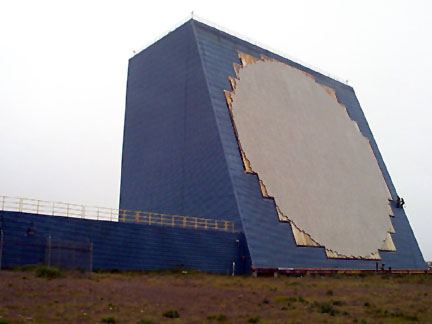 |
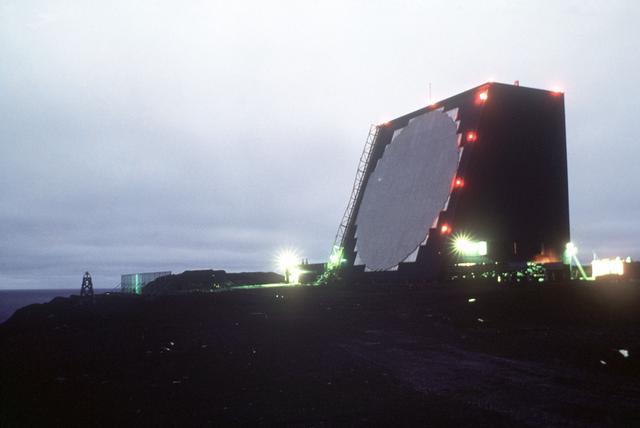 |
Fig. 1 - Cobra Dane radar (courtesy USAF)
|
|
1.2.3
Engineered Phenomena, the Later Years:
As air is heated, it's refractive index declines. A simple
statement with awesome consequences. Suppose a disc shaped
mass of air is heated in such a way as to cause a linear
(smooth) temperature change from the center of the disc to
it's outer edge, with the center being the coldest spot.
The refractive index of the disc will change linearly from
center to edge, with the center having the highest
refractive index. In other words, the disc shaped air mass
will behave as a convex lens (1.1.3, 1.1.4, 1.2.1) bringing
Sun light (and all other parts of the solar electromagnetic
spectrum) into focus at some point in front of the disc.
And since refractive index changes for differing
wavelengths (1.1.3), each portion of the Solar spectrum will
be brought into focus at differing distances from the disc.
The result being that Solar microwave, or even short wave
UV, X-rays & Gamma rays may be brought into focus inside a
structure without significantly altering the apparent level
of visible Sun light outside the structure.
1.2.4
Rebuttal:
Some will argue that short wave UV, X-rays & Gamma rays are
blocked by Earth's atmosphere. This is not completely
accurate. These forms of Solar radiation are greatly
attenuated, NOT blocked by the atmosphere. Some will also
argue that Solar microwave output is very weak compared to
the visible portion of the Solar spectrum. However… What
if the atmospheric lens is 1000 feet in diameter, or even
5000 feet in diameter? A lens one mile in diameter, focused
on a spot 10 feet in diameter, gives a 278,784 :1
concentration factor. Make the lens two miles in diameter
and the concentration factor climbs to well over 1 million.
Solar flares allow further enhancement by increasing the
level of radiation input to the lens (3 of the largest Solar
flares ever recorded occurred in 2003).
1.3.1
Deployment:
The Cobra Dane radar was designed 30 years ago to peer
thousands of miles over the horizon, into hostile territory.
Building an atmospheric lens 20-30 miles up, and 50-90
miles form the intended target, requires nothing even
approaching the behemoth size of Cobra Dane. Size was
further reduced by the rapid advances in microwave and
computer technology during the 80's and 90's. When taken
together, these factors yield a weapon system no larger than
a modern Doppler weather radar. I contend this weapon
system is already deployed around many American cities.
Read on, then decide for your self.
1.3.2
Operational Considerations:
The atmospheric lens weapon system works best from late
spring through early fall for the following reasons. 1.
Extended daylight hours allow more opportunity for weapon
use. 2. Improved Sun angle, allows shorter atmospheric path
with less attenuation or diffusion and improves targeting
angles with less chance of collateral damage. 3. Lower
atmospheric turbulence allows tighter, more precise
focusing. 4. Lower humidity creates less atmospheric
attenuation. It should be obvious that desert conditions
(plentiful sunshine, dry climate, and stable atmosphere)
offer an ideal setting for unrestricted use of this weapon
system.
1.3.3
Political Considerations:
The attacks of 9-11 resulted in a vast restructuring of the
American political landscape. The patriot act legislation,
a direct result of the attacks, is viewed by many citizens
as an egregious infringement of American civil liberties.
Yet at the same time, there are others who believe the
patriot act does not go nearly far enough in granting
government the powers needed to protect American life and
property. Added to this, is the seeming inability of our
courts to dispense justice (without further trashing our
constitution) to those few terrorists our law enforcement
agencies have managed to apprehend. When looked at from
this perspective, is it any wonder that certain elements
within our government should desire a weapon system that so
neatly side steps legislative, judicial, and constitutional
restraints? Sadly, to pursue this mode of thinking (and
acting) leads our great republic further down the path of
administration by unrestrained executive action, thereby
reducing our government to little more than a
military-industrial junta, the very antithesis of democracy.
1.4.1
Atmospheric Lensing Detection:
There are two broad categories of detection. 1. Indirect
detection of atmospheric lensing through it's effects. 2.
Direct detection of the atmospheric lensing beam. I shall
cover each separately, starting with detection of lensing
effects.
1.4.1a
Indirect Detection:
The purpose of atmospheric lensing is to induce human
sickness and/or death. It follows that observation of
biological health is the primary tool of detection. While
humans are the target, ALL living things in the immediate
vicinity are affected to a greater or lesser degree, I will
cover human, animal, and plant life in separate subsections.
Subsection 1: In humans, sub-lethal atmospheric lensing
produces symptoms not unlike radiation poisoning. These
include but not limited to: loss of appetite, irregular or
watery bowel movements, headaches lasting for days,
lethargic behavior, weakness in extremities, mental
confusion, and sleep disturbances. The symptoms will
improve on cloudy or rainy days, and worsen on sunny days
(1.3.2). While these signs are characteristic of many
diseases, a sudden and simultaneous onset of these symptoms
in most or all household members, lasting for days or weeks,
and showing a strong inverse correlation with weather
conditions is NOT a normal disease pattern. Since the
energy beam is tightly focused, the bed ridden and children
too young to walk or crawl, are especially at risk due their
inability to move out of the beam path, and therefore may
show symptom onset slightly ahead of other family members.
Conversely those family members that spend part of the day
away from the residence may exhibit late onset, or milder
symptoms.
Subsection 2: Animal effects in mammals are similar to
humans. However, pets that spend part of the day outdoors
and away from the home may show a reduced level of symptoms.
Aquarium fish seem to be more sensitive than mammals to
atmospheric lensing. The lensing beam has actually been
observed to kill a Beta within 24 hours, and in the process
bleach ALL color out of the fish! This last observation
leads to one possible avenue of detection. Since a Beta
will live in a small fish bowl, they could be used in a
manner similar to that of Canaries in mines. Birds,
rodents, spiders, and other insects will stay well clear of
any structure undergoing atmospheric lensing.
Subsection 3: The effect of atmospheric lensing on plant
life differs markedly from that of humans or animals.
Overall, plants seem to be less susceptible, however this
is offset by the fact that plants do not move. Therefore if
a plant is in the lensing beam path, it will receive a far
greater does of radiation than a human or animal that is
free to move around. Since the lensing beam is tightly
focused, it can create some very odd patterns of plant
death. For instance, one half of a tree may be scorched to
a uniform brownish color in a matter of days, while the
other half remains a vibrant green. Ivy on the shaded side
of a structure may suddenly turn brown and die, as if
exposed to direct sunlight. One part of a shrubbery row may
suddenly die, while the rest remain healthy. These odd
patterns of devastation supply the observer with another
avenue of detection. Draw an imaginary line, from your
living room or bed room to the affected plant. If either
end of that line points at the path of the Sun across the
sky, AND the human symptoms described above are present,
atmospheric lensing is a very strong possibility. The
following pictures show some of these odd plant effects.
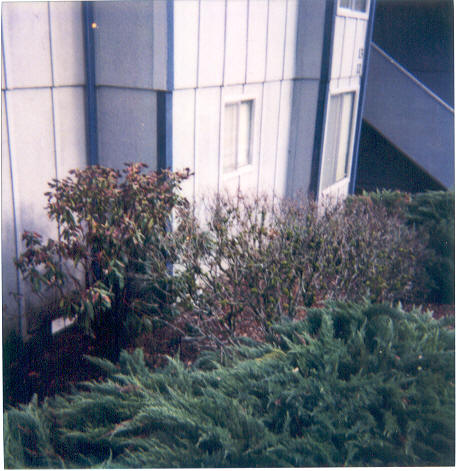 |
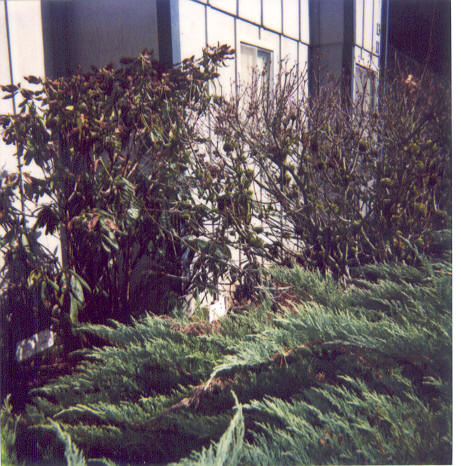 |
An imaginary line from these dead bushes, passing
through authors living room, points to Sun position
in mid afternoon.
|
|
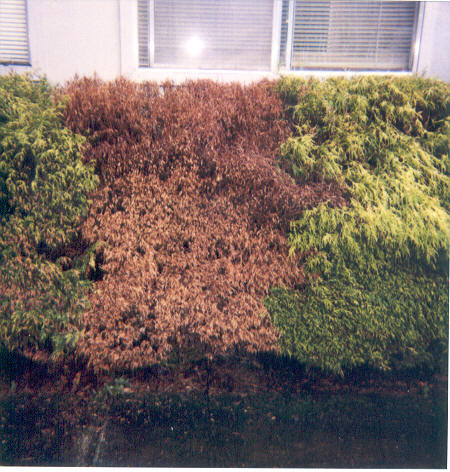 |
|
An imaginary line from this dead shrub, passing
through authors computer desk, points to Sun
position at noon.
|
|
1.4.1b
Direct Detection:
It is possible to construct a simple device that will
reliably detect the atmospheric lensing beam for under
$50.00. The device is called a differential calorimeter.
It measures the difference in heat buildup between
dissimilar materials. As anyone who has ever placed tin
foil in a microwave oven discovers, metallic objects
strongly absorb microwave energy. What is true for
microwaves, is also true for short wave UV, X-rays, and
Gamma rays. The following paragraphs describe construction
and use of the device.
Subsection 1 - Materials Required:
1.
|
One small cardboard box with lid (a shoe box works
good).
|
2.
|
Two foot length of tin foil. (the kind used for
cooking).
|
3.
|
One hand towel. (the cotton variety).
|
4.
|
Two indoor/outdoor remote reading thermometers.
These MUST be the "wired" remote type, NOT the
wireless remote type. Radio Shack Cat. # 63-1035
($14.99) are good, also Oregon Scientific Model #
NAW881 ($16.95) work well.
|
5.
|
Packaging tape (standard scotch tape doesn't work).
|
Subsection 2 - Detector Construction:
1.
|
Fold tin foil in half length wise, forming a 6 inch
by 2 foot (aprox.) double layer of tin foil.
|
2.
|
Wrap tin foil (step 1) tightly around remote sensor
probe of first thermometer, and secure with
packaging tape. Also secure remote sensor cable
where it exits tin foil wrapping so sensor probe
can't slide out of wrapping.
|
3.
|
Wrap hand towel tightly around tin foil/sensor probe
combination (step 2) and secure with packaging tape.
|
4.
|
Place towel/tin foil/probe combination (step 3) in
cardboard box. Drape sensor probe cable over edge
of box, and place lid on box. Secure lid to box
with packaging tape.
|
5.
|
Use packaging tape to secure remote sensor probe of
second thermometer to upper outside edge of
cardboard box. Tape the cable AT the probe, NOT the
probe itself. In other words, the sensor probe
should be completely open to the surrounding air.
|
6.
|
Mark the thermometer readout connected to the sensor
probe inside the box as "detector", and mark the
thermometer readout connected to the sensor probe
outside the box as "reference". Make sure BOTH
thermometer readouts are set to read "outside"
(remote sensor probe) temperature. The detector is
now completed.
|
Subsection 3 - Detector Theory of Operation:
Microwave (or other radiation) will be absorbed by the tin
foil, causing a rise in temperature. The cotton towel will
act as thermal insulation, thereby enhancing the tin foil
temperature rise. The sensor probe connected to thermometer
marked as "detector" measures this temperature rise. The
sensor probe taped to the outside of the box, and connected
to thermometer readout marked as "reference" shows base line
or ambient temperature at the detector. When properly
located and used (see subsection 4), it is the difference
between these two readouts that indicate the presence of an
atmospheric lensing beam.
Subsection 4 - Detector Location and Usage:
Like all scientific instruments, this detector MUST be
properly used if accurate readings are expected. DO NOT
place in direct sunlight, near heaters, or air conditioners.
The atmospheric lensing beam can be very tightly focused
(narrow). Therefore if you work at a desk, or watch TV from
a favorite chair, place detector as close as possible to
that location. Any abrupt change in room temperature will
give false readings (opening or closing a window or outside
door, etc.). Therefore after any such change, give the
detector some time to re-stabilize (30 minutes minimum).
Assuming the above conditions are met, then whenever the
"detector" readout shows a temperature 4 or more degrees
above the "reference" readout, atmospheric lensing is in
progress. Detector readings of 10 or more degrees above
reference ARE life threatening, and immediate evacuation
should be considered.
1.4.2
Counter Measures:
The best counter measure is "get out of the lensing beam
path". Since the beam can be very narrow, changing
locations within a room may be enough. Use the detector
described above (1.4.1) to determine extent of beam path.
However, do not expect more than a temporary reprieve.
With the advent of GPS (global positioning satellite
technology), the lensing beam can be repositioned quickly
(within 20-30 minutes), and with remarkable accuracy.
Basement locations (southeast corner in morning, southwest
corner in afternoon) should provide some shielding.
Concrete structures would also provide some shielding.
However, please remember this weapon system is driven by
the Sun, and is capable of truly awesome power levels. So
far, the only restraint on it's use has been the need for
stealth. If that need were set aside, the lensing beam
could easily start wild fires across a 100 mile swath
(October 2003, San Bernardino & Ventura Counties?), or even
melt sand into glass. The North side of a mountain would
provide an adequate shield, even at these extreme power
levels. Long term, the best counter measure is public
awareness of this weapon system. It's covert use on
American citizenry is blatantly illegal. Those within (and
outside) our government who authorized it's construction,
and condone it's use, do so from the comfortable position of
anonymity. Take away that cloak of secrecy and they will
not long survive the public outrage their actions so richly
deserve.
1.4.3
Summary:
I fully expect that many readers will reject my words as
pure fantasy, or worse as pernicious lies. I further expect
establishment scientists to cite a plethora of reasons why
such weapons could not possibly work, or if that fails, why
such weapons could not be built. So be it. This paper was
not written for them. It was written for the current and
future victims. Victims who (like my self in the beginning)
do not understand what is happening to their lives and lives
of their loved ones. To you the victims, all I can say is:
"You are not alone"…
I have also written this paper to put those who are using
the weapon on notice. I know what you are doing, and how
you are doing it. Soon, many more will know. If you
believe you can hide, you are sadly mistaken.
1.5
Disclaimer:
ALL information contained herein is derived from public
sources, widely accepted scientific principles, and/or
authors first hand experience. The author has NO written or
verbal agreement with ANY governmental agency forbidding
disclosure of the information contained herein. In
disclosing this information, the author is exercising his
right to free speech as a private citizen of the United
States of America.
End
Atmospheric Lensing.



No comments:
Post a Comment